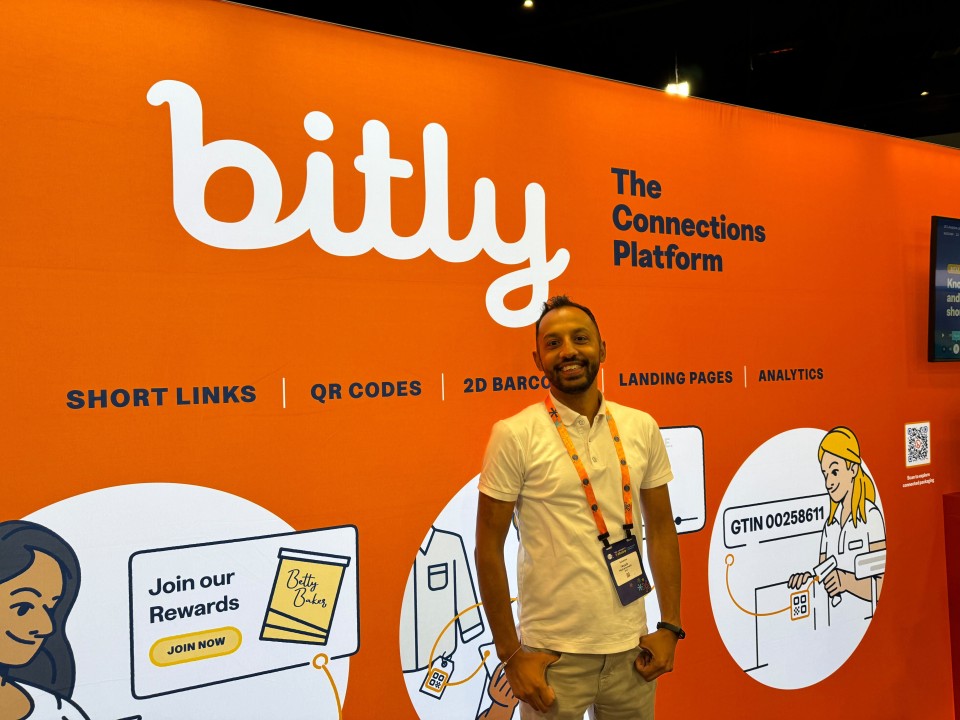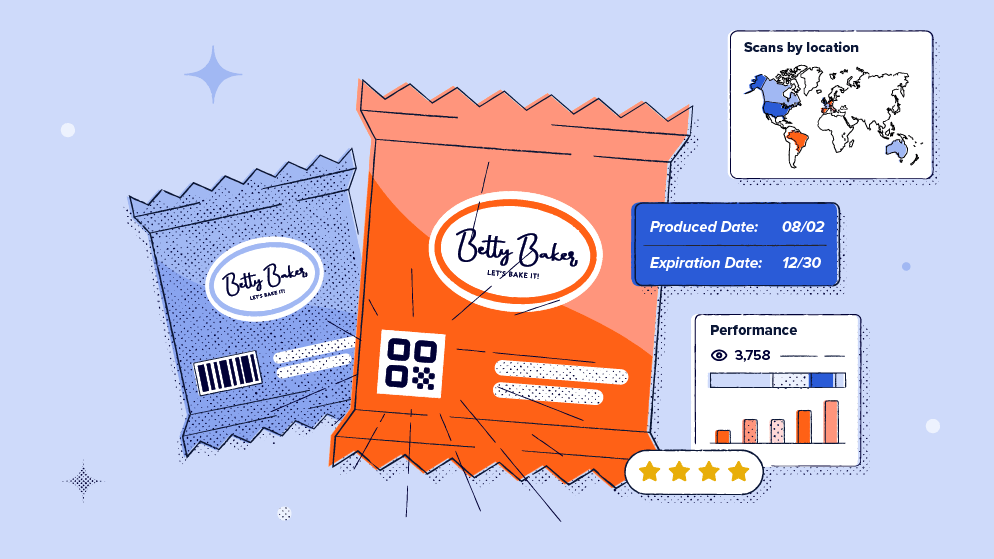Last week, our team attended the GS1 Connect conference to meet with industry experts in the supply chain space and delve into critical challenges facing the retail and CPG industries. Topics ranged from mastering data quality and enhancing supply chain visibility to fostering better data sharing practices and initiating the adoption of new technology.
Throughout the conference, we gathered a ton of valuable takeaways and connected with attendees at our booth and a number of sessions throughout the week—like at our very own Kelsey Stevenson’s panel on connected packaging. There’s a lot to digest and reflect on, and we’re eager to delve deeper!

We sat down with Ayub Mohammed, SVP of Global Sales & Customer Success here at Bitly, to debrief on the event.
We dig into what stood out to him, learn more about the future of connected packaging, and explore how Bitly’s products are set to shape the industry in 2024 and beyond. Let’s get into it!
Can you share a bit about your background and role at Bitly?
Ayub: My background is deeply rooted in understanding and enhancing customer experiences. With nearly 20 years of working in sales and customer success across multiple industries, I’ve had the opportunity to closely collaborate with diverse client bases and adapt to various market dynamics.
Here at Bitly, I lead the sales and customer success teams, where my primary focus is on overseeing our strategic vision and nurturing relationships with our largest enterprise customers. Many of these clients are in the CPG sector, where the demand for innovative, customer-centric solutions is particularly high.
More specifically, my role involves ensuring that our teams deliver exceptional service and provide value to our customers, helping them leverage Bitly’s advanced tools to drive engagement, streamline operations, and achieve their business goals. By aligning our strategic initiatives with the unique needs of each customer, we’re able foster strong, long-lasting partnerships that contribute to mutual growth and success.
What brought Bitly to GS1 Connect this year? How is Bitly involved in the connected packaging space?
Ayub: Over the past five years, we’ve seen incredible growth in QR Code usage on our platform. In the retail and CPG industries alone, we saw an 88% increase in YoY QR Code adoption in 2023. Along with this growth, the number of use cases for connected packaging has also expanded significantly. With over 2 million manufacturers using barcodes on more than 4 trillion products every year, we believe that every box, can, jar, and tag holds an opportunity for CPG companies and retailers to improve their product experience and increase customer engagement.
Attending GS1 Connect this year was an obvious choice for us to showcase our capabilities. Our Connected Platform can help businesses maximize every packaging touchpoint by enhancing digital experiences and delivering instant value to consumers with each interaction.
Bitly is also a Certified Partner of GS1 and we are continuously looking at ways to enhance supply chain efficiencies through the enablement of 2D Barcodes with GS1 Digital Links. We recently launched the industry’s first 2D Barcode API to help enterprise CPG companies and retailers further unlock the opportunities, scalability, and innovation in the packaging industry.

Why do you believe connected packaging is important for retailers and CPG companies?
Ayub: Connected packaging offers brands and businesses the unique ability to forge deeper connections with their customers. It allows them to share instant and consistent product and brand information, usage instructions, and promotional content directly to a consumer’s smartphone. This approach builds trust with consumers by improving product transparency and easy access to the information that they want.
By integrating digital elements into packaging, brands can control the conversation around their products, significantly reducing the risk of spreading misinformation through social media and other sources while also making sure that consumers are well-informed and engaged at every touchpoint.
Can you share any key insights that you have learned from attending GS1 Connect?
Ayub: One consistent theme I observed from attending many speaking tracks this past week, featuring leaders from a wide variety of industries, is the importance of providing accurate, standardized information that is easily accessible.
QR Codes and 2D Barcodes are already helping companies achieve this level of transparent information sharing. And continuing to implement this technology will offer significant opportunities to enhance transparency and engage with consumers more meaningfully. Specifically, 2D Barcodes can carry much more information than traditional barcodes, allowing brands to share detailed product information, track items more efficiently, and interact with customers in new and innovative ways.
“2D Barcodes can carry much more information than traditional barcodes, allowing brands to share product information, track items more efficiently, and interact with customers in new ways.”
Another theme I observed was that many businesses are struggling to implement and share sustainable practices throughout the supply chain. Connected packaging can address this challenge by offering visibility from sourcing to the end consumer, therefore supporting sustainable business practices. It also encourages greater collaboration among supply chain, packaging, and marketing teams. This enables brands to effectively communicate detailed information about their sustainability efforts, including material sourcing, production processes, and recycling instructions.

How do you see QR Codes and 2D Barcodes changing the way retailers and CPG companies connect with customers?
Ayub: QR Codes and 2D Barcodes are already being used in several different ways to enhance brand-consumer connection as well as optimize supply chains by providing critical information to both consumers and suppliers. For example, this may include real-time updates on product recalls or low supply alerts, which helps maintain transparency and trust or be the entry point of the digital product passport journey.
Using QR Codes and 2D Barcodes can also enhance consumer engagement by adding value to their experience. By leveraging the data collected through these codes, brands can create more targeted and meaningful interactions, ultimately fostering greater customer loyalty and satisfaction.
For example, during a panel session at GS1 Connect, Kelsey Stevenson, our Chief Product and Technology Officer (CPTO) at Bitly, shared a case study involving one of our customers, Rad Power Bikes. They utilize Bitly Codes in retail stores and on packaging to create personalized customer experiences that enhance the connection with their products.
How do you see the trends discussed at GS1 Connect shaping the future of retail and CPG industries?
Ayub: The future of the retail and CPG industries is currently undergoing a major transformation. The traditional UPC barcode, which has remained largely unchanged since its introduction in 1974, is now evolving to better meet the needs of the modern consumer. The trends we are hearing at GS1 Connect highlight how this evolution will foster deeper, more personalized relationships between brands and their customers to enhance the buying journey.
There is also an incredible opportunity for QR Codes and 2D Barcodes to provide rich, interactive experiences that go beyond product information. As the technology and practices continue to evolve, consumers will only be able to access more and more detailed insights about a product’s origin, sustainability practices, and usage tips—all through a quick scan. These advancements will help businesses gather more valuable insights on consumer preferences and behaviors, allowing for more targeted and effective marketing strategies and making each interaction more relevant and engaging.
“These advancements will help businesses gather insights into consumer preferences and behaviors, allowing for more targeted and effective marketing strategies.”
Before we wrap up, would you like to share any final thoughts or reflections on the event?
Ayub: We have a journey ahead of us to create seamless experiences where every interaction, from the supply chain to the consumer, is connected and optimized. This vision involves using demand signals to ensure the right product is available at the right time, ensuring a fulfilling consumer experience.
The insights and trends discussed at GS1 Connect 2024 will undoubtedly play a crucial role in shaping the future of the retail and CPG industries. The evolution of connected packaging, driven by advancements in QR Codes and 2D Barcodes, presents an exciting opportunity for brands to deepen their relationships with consumers through enhanced transparency, accessibility, and sustainability.
At Bitly, we’re committed to continuing our innovation in this space, empowering businesses to leverage these technologies to create more meaningful connections and optimize their supply chains. The journey towards a more integrated, consumer-centric future is just beginning, and we’re excited to be at the forefront, partnering with industry leaders like GS1 to drive this transformation.




